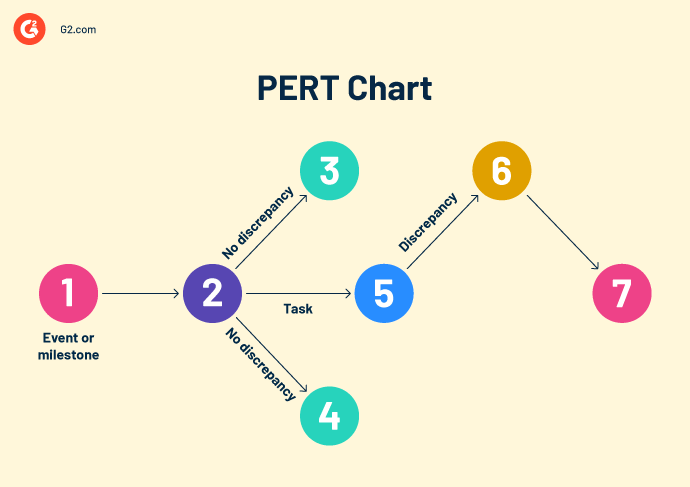
What Is a PERT Chart? How to Use One in Project Management
Staying on top of every part of a project is always a challenge, but an effective project management strategy helps prevent important tasks and milestones from falling through the cracks. One of the best ways to achieve this is through visualization, specifically using PERT charts to schedule and organize different aspects of your projects.
What is a PERT chart?
A project evaluation and review technique, or PERT, chart is a graphic that shows the entire project timeline and its individual tasks.
Like a Gantt chart, they’re a critical tool in project management, but they have their own look and they don’t usually apply specific dates like a Gantt chart would. PERT charts may also be called network diagrams, due to their usage of free form nodes that represent tasks and their corresponding dependencies.
Originally implemented by the US Navy in the 1950s, PERT charts have become crucial to project workflows across industries. Almost all project management software now comes with the ability to create digitized PERT charts to share among team members.
What are necessary components of a PERT chart?
One of the benefits of using a PERT chart is their simplicity for the most basic projects. Only three components have to be included in a PERT chart.
- Numbered nodes: Each task should be listed on the chart as its own individual, numbered node. Nodes are all connected to denote how they help move the project forward.
- Directional arrows (dependencies): The arrows in a PERT chart demonstrate how individual tasks or milestones are connected and what needs to be completed before teams can move on to the next task.
- Divergent arrows: Any arrows that come from a single node but move toward different nodes are considered divergent arrows. These are tasks that can be completed simultaneously, rather than in sequential order.
How PERT charts are used
PERT charts are best-suited for simple projects because the number of individual tasks and dependencies that come with more complex projects can result in a cluttered chart.
The three best reasons to use a PERT chart are when you need to:
- Evaluate resources. Because each task is its own circular or rectangular node, it makes it easier to see where resources are lacking. Some nodes may not require anything extra, while others could have gaps. The evaluation allows project teams to plan ahead and arrange to gather what they need.
- Estimate time. You can see both the individual task duration and the total project duration on a PERT chart. This helps project managers accurately forecast their overall timelines for project completion.
- Determine the critical path. The critical path is the longest possible sequence of tasks and dependencies that must happen for a project to reach its final outcome. If these tasks aren’t completed, the whole project timeline changes. PERT charts show both the critical path and alternatives to get to the same endpoint, allowing project managers to figure out which tasks to remove or deprioritize to finish faster.
How to make a PERT chart
No matter what your project is, there are five steps in the process timeline that need to occur to ensure a project’s successful completion.
Identifying tasks
Once a project has been approved, the project manager breaks down the individual tasks that need completion. At this point, the manager should assign the tasks to relevant team members to determine if enough resources are available.
Defining discrepancies
Milestones that rely on another item’s completion should be linked in the PERT chart with a dependency arrow. This is known as a logical relationship. Joining them together in this way helps project managers more effectively track the tasks and their deadlines.
For more complex projects, mapping out the dependencies of tasks ahead of the project start date can save significant time. Without doing this, project delays are more likely, which can steal time from other projects or even make a project run over budget.
While PERT charts aren’t as detailed as a complete work breakdown structure, they still offer useful insight into which tasks need to be completed at various stages.
Connecting nodes
The visualization of a PERT chart comes when nodes and dependencies are created and connected to each other as arrows. The arrows represent the order that tasks need to be finished. Dotted lines denote tasks that need to be completed before moving to the next milestone, but which lack the resources to do so.
Estimating timeframes
Using the critical path method, project managers study their PERT charts to determine how long each milestone will take. The main objective when mapping out the timeline of the project is to find the longest path that takes the most time. This determines the shortest overall project duration, based on three concepts.
- Optimistic time is the estimated, minimum amount of time it takes to complete a task.
- Pessimistic time is the maximum amount of time a task should take.
- Most likely time is the project manager’s best estimate based on the optimistic and pessimistic timeframes.
Once all tasks have their own timeframe, the manager can determine project duration for best and worst-case scenarios.
Managing progress
As teams work through the PERT chart, managers update the chart in real time to close dependencies and deal with any issues that arise during the lifecycle of the project. Once all tasks have been checked off, the project should be completed and the chart can be archived for reference.
Top project management software
Effective project management software makes the overall completion of a project more efficient. Teams can use these tools to view task allocations, project timelines, and communicate with other members of the team about aspects of the project.
To be included in the project management software category, platforms must:
- Create project plans and work breakdown structure (WBS) based on scope
- Define, manage, and allocate resources based on demand and availability
- Make project budgets and compare them with actual costs and expenses
- Support multiple project management methodologies such as waterfall and agile
- Provide project templates that can be modified or combined to create new projects
- Manage interdependencies between tasks and their impact on deadlines
- Automatically generate a critical path and update it when the project changes
- Allow users to mass update tasks without changing interdependencies
- Include multiple project views such as calendar view or customer view
- Monitor project progress, resource utilization, and user productivity
* Below are the top five leading project management software solutions from G2’s Winter 2024 Grid Report. Some reviews may be edited for clarity.
1. Smartsheet
Smartsheet helps teams manage their projects, automate processes, and gain greater visibility into programs and portfolios. Organizations of all sizes and across various industries often use Smartsheet to manage portfolios at scale – all on a single, accessible from anywhere, on any device.
What users like best:
“The reminders set up in Smartsheet help prevent the delay for work. It is very useful in team collaboration and presenting data in an attractive format. One of the best features is that we can attach multiple files easily.”
– Smartsheet Review, Arjun S.
What users dislike:
“When multiple people are entering information in the shared sheet, it causes incorrect data flow due and the data needs to be saved manually at each step. ”
– Smartsheet Review, Jasleen G.
2. monday.com
monday.com provides businesses with an intuitive platform featuring custom dashboards, automations, and integrations for any type of project management. Teams that use monday.com are empowered to build their ideal workflow.
What users like best:
“I love how customizable the platform is. We can section staff into teams to ensure the right info is displayed to the right people – this keeps things clean and allows us to categorize the content that’s applicable for different teams. The boards are also super customizable depending on what kind of information you want to display.”
– monday.com Review, Emily B.
What users dislike:
“Their automations are also incredibly limiting, you end up needing to create massive workarounds to do something that seems fairly standard.”
– monday.com Review, Charlie L.
3. Asana
With Asana, teams can work on anything big or small thanks to the integrated automations and workspaces within the platform. It helps teams orchestrate their cross-functional work, from daily tasks to strategic initiatives.
What users like best:
“Asana has multiple features that are helpful and easy to use. I love how they are always adding new features and tools. This is a great platform for collaborating with colleagues and clients. Asana can also integrate with apps that you use daily, and the implementation process is easy. Asana can be used in several different ways, and you can customize your view to fit the type of project you are working on.”
– Asana Review, Dustin A.
What users dislike:
“The user interface can be a bit overwhelming for a new user and also the pricing is a bit on the higher side in case of paid plans.”
– Asana Review, Garvit M.
4. ClickUp
ClickUp is an all-in-one productivity platform that allows teams to plan, organize, and collaborate using the integrated features within the tool. It plays well with Google Docs, Chat, and Goals to ensure teams are able to hit all milestones.
What users like best:
“As a manager it gives me an overview of all the projects that my team is working on. What’s even better is that I can trickle down specifically what the details of the project are, who is the owner, what is the current status/update, and when the due date is. Teams can easily collaborate with each other, and in the comments section, members can tag each other.”
– ClickUp Review, John Epok P.
What users dislike:
“ClickUp has prioritized the release of new features and user experience 3.0 over stability and load speeds. Although they have touted a completely new technology overhaul for 2024, there are times where the load times are awful and even require a page refresh at times.”
– ClickUp Review, Hunter N.
5. Notion
Notion is a connected workspace where teams create documents, take notes, share tasks, and organize tasks. It also offers AI-powered tools to manage any project from beginning to end.
What users like best:
“It allows me to organize my work, manage projects, and even create a comprehensive personal dashboard. I find the interface intuitive and the features extensive. Notion has become my go-to for almost all my productivity needs.”
– Notion Review, Megan W.
What users dislike:
“Sometimes it’s quite hard to set up in the first place. When I was first introduced to Notion, I found the platform quite overwhelming.”
– Notion Review, Jordan B.
PERT is the way to go!
If you’ve never explored PERT charts before, they can feel a little challenging to begin with. But once you find a way to make them work for you and your team, you’ll find yourself completing projects more efficiently and with greater transparency.
If a PERT chart isn’t right for your needs, learn more about Gantt charts and how to use them.
